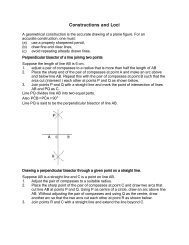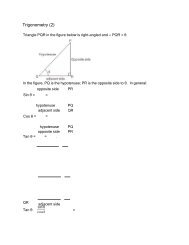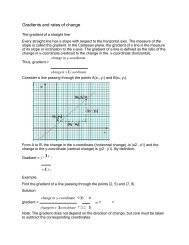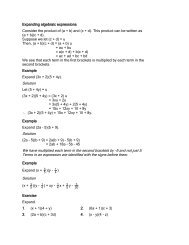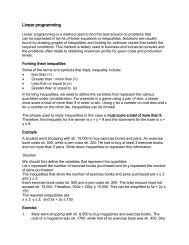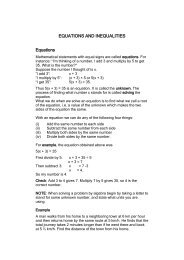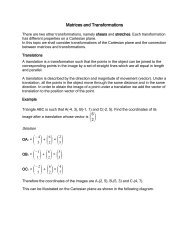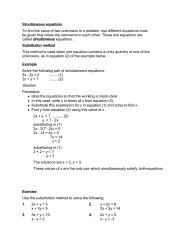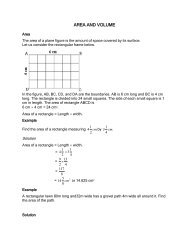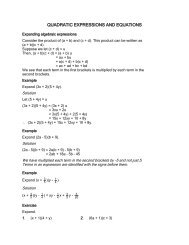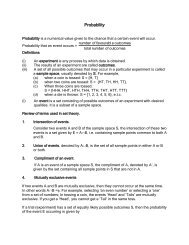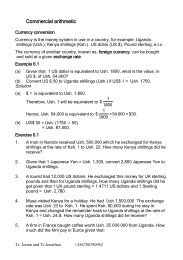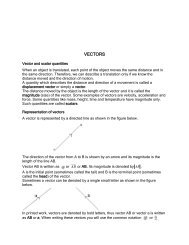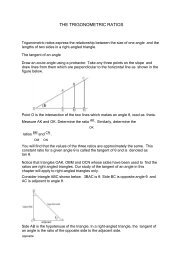J15
Create successful ePaper yourself
Turn your PDF publications into a flip-book with our unique Google optimized e-Paper software.
Matrices<br />
A matrix is a rectangular array of numbers. It is enclosed by large curved brackets. Each<br />
number of the array is called an entry (or an element). The elements are arranged in<br />
rows and columns. Rows are across the page, i.e. horizontal, and columns are vertical.<br />
Matrices (plural of matrix) are often used for data storage.<br />
Matrices are represented by capital letters and written with a wavy line underneath. For<br />
example, a matrix can be written as<br />
2<br />
4 - 3<br />
A = A = <br />
. In text books it is printed in bold A.<br />
1<br />
7 0<br />
Order of a matrix<br />
The order of a matrix is the number of rows and columns in the matrix. For example,<br />
2<br />
4 - 3 <br />
<br />
is of order 2 × 3 (read as ‘two by three’) because it has 2 rows and 3 columns.<br />
1<br />
7 0<br />
Notice that the number of rows is given first. This can be remembered by the first letters<br />
of the words Resistance Council: R × C.<br />
If the number of rows in a matrix equals the number of columns, the matrix is called a<br />
square matrix. For example,<br />
a<br />
b<br />
<br />
.<br />
c<br />
d<br />
A matrix with only one row is called a row matrix.<br />
A matrix with only one column is called a column matrix.<br />
Elementary operations with matrices<br />
Two matrices of the same order can be added or subtracted by adding (or subtracting)<br />
the corresponding elements of the matrices to give a third matrix.<br />
2 1 1 1 <br />
2 1 11<br />
1 2 <br />
<br />
<br />
For example, 3 7<br />
+ 1 0<br />
= 3 1 7 0<br />
= 2 7 <br />
<br />
6 9<br />
<br />
3 1<br />
<br />
<br />
6 3 9 1<br />
<br />
9 10<br />
2 1 1 1 2 1 11<br />
3 0<br />
<br />
<br />
And 3 7<br />
- 1 0<br />
= 3 ( 1)<br />
7 0<br />
= 4 7<br />
.<br />
<br />
6 9<br />
<br />
3 1<br />
<br />
<br />
6 3<br />
9 1<br />
<br />
3 8 <br />
Note: Given any two matrices A and B, then A + B = B + A (commutative property).<br />
Also, (A + B) + C = A + (B + C) (Associative property).<br />
Multiplication of a matrix by a scalar<br />
To multiply a matrix A by a scalar k (a real number), we multiply each number,<br />
i.e. each element of the matrix by k.<br />
1<br />
1 7<br />
For example, if P = <br />
1<br />
1 7<br />
then 3P = 3 ×<br />
0<br />
2 6<br />
3<br />
3 21<br />
=<br />
<br />
0<br />
2 6<br />
<br />
.<br />
0<br />
6 18<br />
Matrix multiplication
In matrix multiplication, each row of the first matrix is multiplied by each column<br />
of the second matrix. In the multiplication of a row by a column, each element in the row<br />
is multiplied by the corresponding element in the column and then the products added.<br />
p<br />
<br />
For example, (a b c) q<br />
<br />
r<br />
<br />
= (ap + bq + cr).<br />
Note: Two matrices can be multiplied if the number of columns in the first matrix is equal<br />
to the number of rows in the second matrix. For example, if<br />
3<br />
7 <br />
<br />
1<br />
2<br />
P = 2<br />
6<br />
and Q = <br />
<br />
<br />
1<br />
0<br />
3<br />
4<br />
<br />
then PQ can be found as P has 2 columns and Q has 2 rows.<br />
3<br />
7 31<br />
73<br />
32<br />
74<br />
3<br />
21 6 28 24<br />
34 <br />
1<br />
2<br />
<br />
<br />
<br />
PQ = 2<br />
6<br />
<br />
= 21<br />
63<br />
22<br />
64<br />
= 2<br />
18<br />
4 24<br />
= 20<br />
28<br />
<br />
1<br />
0<br />
3<br />
4<br />
<br />
<br />
11<br />
03<br />
1<br />
2 04<br />
<br />
<br />
1<br />
0 2 0<br />
<br />
1 2 <br />
P has order 3 × 2, Q has order 2 × 2 and so PQ has order 3 × 2.<br />
QP cannot be found because the number of rows in Q is not equal to the number of<br />
columns in P.<br />
Note:<br />
(i) In general PQ ≠ QP. (Matrix multiplication is not commutative).<br />
(ii) If P is (m × n) matrix and Q is (n × p) matrix, then Q can be premultiplied by P.<br />
P × Q = R<br />
(m × n) (n × p) (m × p)<br />
(iii) In matrices A 2 means A × A. You must multiply the matrices together.<br />
Whereas, 2A means 2 × A.<br />
Example<br />
Perform the following multiplications.<br />
1<br />
0 <br />
3<br />
2<br />
(a) 2<br />
1<br />
2<br />
1 - 2<br />
<br />
4<br />
1<br />
<br />
(b)<br />
1<br />
5<br />
<br />
1<br />
- 2 <br />
<br />
0<br />
1 3<br />
<br />
4<br />
3<br />
Solution<br />
(a)<br />
(b)<br />
Example<br />
1<br />
If A =<br />
<br />
3<br />
3<br />
2<br />
2<br />
<br />
4<br />
1<br />
<br />
1<br />
1<br />
0 <br />
2<br />
1 - 2<br />
<br />
1<br />
- 2 <br />
0<br />
1 3<br />
<br />
4<br />
3<br />
1<br />
62<br />
310<br />
=<br />
5<br />
8 13<br />
<br />
=<br />
81<br />
45<br />
<br />
<br />
9<br />
9 <br />
218<br />
026<br />
= <br />
<br />
01<br />
12 029<br />
<br />
5 8<br />
= <br />
<br />
13 7<br />
0<br />
x 0<br />
, B =<br />
2<br />
<br />
, and AB = BA, find x.<br />
1<br />
3
Solution<br />
1<br />
0<br />
AB = x 0<br />
x<br />
0<br />
00<br />
<br />
3<br />
2<br />
<br />
=<br />
1<br />
3<br />
x 0<br />
<br />
=<br />
3x<br />
2 06<br />
<br />
<br />
3x<br />
2<br />
6<br />
x 0<br />
BA = 1<br />
0 x<br />
0<br />
00<br />
<br />
1<br />
3<br />
<br />
=<br />
3<br />
2<br />
x<br />
0<br />
<br />
=<br />
1<br />
9 06<br />
<br />
<br />
10<br />
6<br />
Equating AB and BA, we get<br />
0 x<br />
0<br />
<br />
=<br />
3xx 2<br />
6<br />
<br />
<br />
10<br />
6<br />
Note: When two matrices are equal, then their corresponding elements must also be<br />
equal. Thus,<br />
3x + 2 = 10<br />
3x = 8<br />
x =<br />
8<br />
3<br />
Example<br />
2x<br />
1<br />
If 3<br />
2<br />
+<br />
0 4 9<br />
3<br />
=<br />
2<br />
1 <br />
, find the value of x.<br />
2<br />
5<br />
Solution<br />
2x<br />
1 3<br />
2<br />
<br />
+<br />
0 4 2x<br />
3 3<br />
=<br />
2<br />
1<br />
9<br />
3<br />
=<br />
2 5 <br />
<br />
2<br />
5<br />
By equating the corresponding elements of both sides, we get<br />
2x + 3 = 9 2x = 6 x = 3.<br />
Example<br />
5 5<br />
Given that B = <br />
, find k if B 2 = kB.<br />
2 2<br />
Solution<br />
B 2 5 5<br />
= 5 5<br />
25 10<br />
25 10<br />
<br />
2 2<br />
<br />
=<br />
2 2<br />
15 15<br />
<br />
=<br />
10 4 10 4<br />
<br />
<br />
6 6<br />
It can be seen that B 2 15 15<br />
= 5 5<br />
= 3 ×<br />
6 6<br />
<br />
= 3B<br />
2 2<br />
Therefore, the value of k for which B 2 = kB is 3.<br />
Example<br />
2<br />
3<br />
Given P = 14 2<br />
, Q =<br />
2<br />
1<br />
16<br />
20<br />
and R =<br />
8 6<br />
<br />
calculate:<br />
32<br />
4 <br />
(a) 5Q – 3P (b) 1 Q + R<br />
2<br />
Solution<br />
14 2<br />
(a) 5Q – 3P = 5 2<br />
3<br />
- 3<br />
8 6<br />
<br />
<br />
2<br />
1
(b)<br />
Example<br />
70 10<br />
= 6<br />
9<br />
-<br />
40 30<br />
<br />
<br />
6<br />
3<br />
70 6<br />
10 9<br />
= 64 19<br />
<br />
=<br />
<br />
40 6<br />
30 3<br />
<br />
<br />
46 27<br />
1<br />
2<br />
Q + R = 1 × 14 2<br />
2 16<br />
20<br />
+<br />
8 6 <br />
<br />
32<br />
4 <br />
7 1<br />
= 16<br />
20<br />
+<br />
4 3<br />
716<br />
1<br />
20<br />
=<br />
32<br />
4<br />
<br />
<br />
<br />
432<br />
3<br />
4 <br />
23<br />
21<br />
= <br />
.<br />
28<br />
7 <br />
Three garages G 1, G 2 and G 3 sell cars of two types A and B. The sales in one<br />
week are shown in the table below together with a matrix showing the price<br />
paid for each type.<br />
Sales:<br />
Type<br />
Garage A B<br />
G 1 3 1<br />
G 2 2 0<br />
G 3 4 1<br />
A:<br />
5000<br />
Prices (in dollars): <br />
<br />
B:<br />
7500<br />
Write down the sales as a 3 × 2 matrix and hence work out the total value of<br />
sales for the three garages.<br />
Solution<br />
Sales:<br />
A B<br />
G 1 3<br />
1 <br />
<br />
G 2 2<br />
0<br />
G <br />
3 4<br />
1 <br />
The total value of sales for the three garages is given by the matrix product<br />
3<br />
1 <br />
15000<br />
7500 22500<br />
<br />
5000 <br />
<br />
2<br />
0<br />
<br />
= 10000<br />
0 = 10000<br />
<br />
<br />
4<br />
1<br />
7500 <br />
<br />
<br />
20000<br />
7500<br />
<br />
27500<br />
<br />
The total sales for each garage are t herefore given in the following matrix<br />
G 1<br />
G 2<br />
G 3<br />
Value of sales ($)<br />
22500<br />
<br />
<br />
10000<br />
<br />
<br />
27500
Zero (or null) matrix<br />
A matrix with all its elements zero is called a zero matrix. If to a given matrix A,<br />
a zero matrix (of the same order) is added, the value of A is unchanged.<br />
However, if we multiply a matrix by the zero matrix we get a zero matrix.<br />
Thus, A + O = A and AO = OA = O, where O is the zero matrix.<br />
Identity (or Unit Matrix)<br />
A square matrix in which the elements of the leading (or major) diagonal are 1<br />
and the other elements are zero is called the identity matrix, and is denoted by<br />
I.<br />
1<br />
0<br />
Thus, an identity matrix of order 2 × 2 will be I = <br />
.<br />
0<br />
1<br />
An identity matrix of order 3 will be<br />
1<br />
0 0 <br />
<br />
I = 0<br />
1 0<br />
<br />
0<br />
0 1 <br />
2<br />
3<br />
If A = <br />
is a 2 × 2 matrix, then AI =<br />
1<br />
4<br />
1<br />
0<br />
And IA = 2<br />
3 2<br />
3<br />
<br />
0<br />
1<br />
<br />
=<br />
1<br />
4 <br />
= A.<br />
1<br />
4<br />
Hence, AI = IA = A.<br />
Also I 2 1<br />
0<br />
= I × I = 1<br />
0<br />
1<br />
0<br />
<br />
0<br />
1<br />
<br />
=<br />
0<br />
1 <br />
= I<br />
0<br />
1<br />
In general, I n = I.<br />
2<br />
<br />
1<br />
3<br />
<br />
4<br />
1<br />
<br />
0<br />
0<br />
<br />
1<br />
2<br />
3<br />
= <br />
<br />
1<br />
4<br />
= A<br />
Exercise<br />
In questions 1 – 3, find the value of the following<br />
1<br />
<br />
<br />
1. 0<br />
+<br />
<br />
0<br />
2<br />
<br />
1<br />
<br />
<br />
3<br />
1<br />
<br />
<br />
3<br />
2. 2 <br />
1<br />
<br />
<br />
5<br />
1<br />
<br />
<br />
0<br />
+ 4 <br />
1<br />
<br />
<br />
6<br />
1<br />
2 <br />
3. 8 <br />
2 13<br />
2<br />
<br />
5<br />
3<br />
17<br />
16<br />
1<br />
2<br />
4. If A = 5<br />
3<br />
, B =<br />
3<br />
1<br />
<br />
5 3<br />
and C =<br />
6<br />
2<br />
<br />
<br />
<br />
-<br />
4 2<br />
(a) Calculate A + B and B + A.<br />
(b) Calculate: (i) 3A + 2B, (ii) 2B – 3C, (iii) 2A – 1 (B + C) 2
From the following matrix equations, determine the values of x and y.<br />
x<br />
2y<br />
14<br />
5. <br />
<br />
<br />
3 y 2<br />
4 14<br />
= <br />
<br />
<br />
3 73x<br />
<br />
6.<br />
<br />
<br />
1 x<br />
x<br />
4<br />
2<br />
12<br />
<br />
3<br />
<br />
1 7x<br />
= <br />
<br />
x<br />
4 3<br />
7.<br />
<br />
<br />
4x<br />
<br />
3<br />
2<br />
5 <br />
16<br />
5<br />
=<br />
2<br />
y 4<br />
<br />
<br />
3 0<br />
In the following matrix equations, find the value of x.<br />
8.<br />
2x<br />
3<br />
x 1<br />
=<br />
1 0<br />
6<br />
2<br />
+<br />
1 0 <br />
<br />
0<br />
0<br />
9.<br />
<br />
<br />
x 2 1 2x<br />
3<br />
+ 1<br />
3<br />
3<br />
4<br />
=<br />
2 4<br />
<br />
<br />
3<br />
7 <br />
10. Find the values of a, b, c and d if:<br />
2<br />
5<br />
b<br />
c<br />
<br />
-<br />
3<br />
a 1<br />
9<br />
=<br />
3<br />
4 <br />
<br />
d<br />
4<br />
x<br />
3 7<br />
11. If A = <br />
<br />
4<br />
0 6y <br />
and B =<br />
1<br />
y<br />
<br />
12<br />
9<br />
0<br />
21<br />
<br />
36<br />
and 3A = B, find the values of x and y.<br />
12.<br />
2<br />
3<br />
If A = <br />
1<br />
0<br />
and B =<br />
1<br />
4<br />
<br />
, find:<br />
<br />
2<br />
1<br />
(a) A 2 , (b) 2AB<br />
(c) A(A + B).<br />
x 4<br />
13. If 2 4 <br />
0<br />
0<br />
<br />
=<br />
3 <br />
, find the value of x.<br />
0<br />
14.<br />
2<br />
3<br />
If K = 8<br />
and L =<br />
5<br />
8<br />
<br />
<br />
5<br />
(a) find IL and LI,<br />
(b) find I 2 K and KI 2 .<br />
3<br />
<br />
,<br />
2<br />
15. (a) (2 3 5) K = (-1 0 8 2 4). What is the order of matrix K?<br />
(b) If A is a 3 × 4 matrix and C is a matrix such that A + B = C, what is the is the<br />
order of B and of C?<br />
16. (a) If a 2 × 5 matrix is multiplied by a 5 × 3 matrix, what is the order of the<br />
product?<br />
(b) If A is a 3 × 5 matrix and B is a matrix such that AB and BA are both<br />
possible, what is the order of B?
1<br />
1<br />
17. If A = <br />
and A 2 = I, find the values of x and y.<br />
x<br />
y<br />
1<br />
3<br />
18. If the matrices P = <br />
5 1<br />
and Q =<br />
4 2<br />
<br />
<br />
<br />
1 0<br />
(a) PQ – QP, (b) (P + Q) 2<br />
x<br />
6<br />
19. If x<br />
x <br />
0<br />
1<br />
<br />
=<br />
1<br />
<br />
, find the possible values of x and y.<br />
y<br />
<br />
20. In an athletics meet in a school, the Blue House got 3 firsts, 4 seconds and nil third<br />
in track events and1 first, 2 seconds and 1 third in relays. The point system is as<br />
follows:<br />
First Second Third<br />
Track 3 2 1<br />
Relay 7 5 2<br />
Give this information in the form of two matrices. Multiply the matrices together<br />
and label rows and columns of your answer to indicate what the entries represent.<br />
21. Three ladies P, Q and R went for shopping. P bought 2 kg of sugar, 4<br />
1<br />
kg of tea<br />
and 1 loaf of bread; Q bought 10 kg of sugar, 2<br />
1<br />
kg of tea and 2 loaves of bread; R<br />
bought 5 kg of sugar, 4<br />
1<br />
kg of tea and 1 loaf of bread. Write this information in the<br />
form of a 3 × 3 matrix.<br />
The prices are: Sugar sh. 1,500 per kg, tea sh. 2,000 per kg and sh. 1,000 for one<br />
loaf of bread. Use matrix multiplication to find the total amount of money spent by<br />
each of P, Q and R. Label rows and columns of your answer to indicate what the<br />
entries represent.<br />
22. The results of four soccer teams are shown below together with a matrix showing<br />
how points are awarded.<br />
A<br />
B<br />
C<br />
D<br />
W D L<br />
7<br />
3 5 <br />
<br />
5<br />
4 2<br />
<br />
8 2 5<br />
<br />
<br />
6<br />
3 4<br />
Points<br />
W 4<br />
<br />
D 1<br />
<br />
L <br />
0<br />
Multiply the matrices and hence state which team has most points.
23. A restaurant sells three meals A, B and C. In two days the sales were as shown in<br />
matrix S.<br />
A<br />
B<br />
C<br />
Mon<br />
10<br />
<br />
15<br />
<br />
10<br />
Tue<br />
5 <br />
<br />
20<br />
10<br />
<br />
<br />
S =<br />
The price in shillings paid for each meal is given by matrix P.<br />
A B C<br />
2000<br />
4000 7000<br />
P =<br />
Work out the matrix product PS and interpret the result.<br />
The Determinant of a 2 × 2 Matrix<br />
a<br />
The determinant of M =<br />
<br />
c<br />
a<br />
It is denoted by det M or<br />
c<br />
b<br />
<br />
is the scalar ad – bc.<br />
d<br />
b<br />
.<br />
d<br />
Note: The elements a and d are in the major or leading diagonal while b and c are in the<br />
minor diagonal.<br />
Determinant of a 2 × 2 matrix = Product of elements in major diagonal minus<br />
the product of elements in the minor diagonal.<br />
The inverse of a 2 × 2 matrix<br />
a<br />
b<br />
The inverse of a matrix M = <br />
, written as M -1 , is given by<br />
c<br />
d<br />
M -1 = 1 d b<br />
detM<br />
<br />
<br />
-<br />
c a<br />
d b<br />
The matrix <br />
is called the ad joint of matrix M.<br />
-<br />
c a<br />
The adjoint of M is obtained by interchanging the elements in the major<br />
diagonal and changing the signs of the elements in the minor diagonal.<br />
Note:<br />
(i) Given a matrix M, if det M = 0 then M -1 cannot be found. In this case M is said to<br />
be singular.<br />
(ii) If M -1 is the inverse of M, then MM -1 = M -1 M = I.<br />
Example<br />
1<br />
Find the inverse of A =<br />
<br />
4<br />
Solution<br />
2<br />
<br />
.<br />
11
Change 11 and 1 over and change the signs of 2 and 4 to obtain,<br />
11<br />
2<br />
<br />
<br />
-<br />
4 1<br />
Find the determinant of A. That is, det A = (11 × 1) – (4 × 2) = 11 – 8 = 3.<br />
11 <br />
Then A -1 =<br />
1 11<br />
2<br />
2<br />
3 <br />
<br />
3 3 <br />
= .<br />
-<br />
4 1<br />
-<br />
4 1 <br />
3 3 <br />
Example<br />
Calculate the determinant and hence the inverse of the following matrices<br />
where possible.<br />
4 2<br />
(a) <br />
1 1<br />
<br />
(b)<br />
2<br />
1<br />
<br />
<br />
<br />
1 1<br />
Solution<br />
(a)<br />
(b)<br />
4 2<br />
= 4 × 1 – 2 × 2<br />
2 1<br />
= 4 – 4 = 0<br />
Since the determinant is 0 the inverse cannot be found.<br />
1<br />
- 1<br />
1<br />
1<br />
= 1 × 1 – (-1) × 1<br />
= 1 + 1 = 2<br />
1 1<br />
Inverse of <br />
is<br />
1 1<br />
1<br />
1 1 1<br />
<br />
=<br />
2<br />
<br />
2 1 1<br />
1<br />
2<br />
<br />
1 <br />
2 <br />
.<br />
1 <br />
2 <br />
Note: If A, B and C are matrices such that AB = C, then<br />
A -1 AB = A -1 C<br />
IB = A -1 C, since A -1 A = I<br />
B = A -1 C (IB = B).<br />
Example<br />
If B =<br />
3<br />
<br />
1<br />
Solution<br />
4<br />
<br />
and AB = I, find A.<br />
2<br />
Since AB = I A is the inverse of B.<br />
3 4<br />
= 3 × (-2) – 1 × (-4)<br />
1 2<br />
= -6 - (-4) = -6 + 4 = -2<br />
B -1 =<br />
1 -<br />
2 4<br />
1 - 2 <br />
<br />
2<br />
<br />
= <br />
- 1 3 1 <br />
<br />
3<br />
2 2
1 - 2 <br />
Therefore, A = <br />
1<br />
<br />
3 .<br />
2 2 <br />
Solution of simultaneous equations by matrix method<br />
A pair of simultaneous equations can also be written in matrix form to obtain the<br />
required solutions.<br />
Example<br />
Solve the following pair of simultaneous equations:<br />
2x – 3y = 7; 4x + 3y = 5<br />
Solution<br />
Expressing the equations in matrix form we have,<br />
M<br />
2<br />
3<br />
x<br />
7 <br />
<br />
4<br />
3<br />
<br />
=<br />
y<br />
<br />
where M is the matrix of the coefficients.<br />
5<br />
Write down the inverse of M which is 1 3 3<br />
<br />
<br />
18 4 2<br />
3 3<br />
Premultiply both sides of the equation by <br />
. We need not multiply by<br />
1<br />
4 2<br />
18<br />
as multiplying both sides by<br />
1<br />
does not alter the equation.<br />
18<br />
3 3<br />
2<br />
3<br />
x<br />
3 3<br />
<br />
<br />
4 2<br />
<br />
<br />
4<br />
3<br />
<br />
=<br />
y<br />
7<br />
<br />
4 2<br />
<br />
<br />
5<br />
18<br />
0 x<br />
36<br />
<br />
<br />
0 18<br />
<br />
=<br />
y<br />
<br />
<br />
-18<br />
1<br />
0<br />
18 x<br />
2<br />
<br />
0<br />
1<br />
<br />
= 18<br />
y<br />
<br />
<br />
- 1<br />
1<br />
0<br />
x<br />
2<br />
<br />
<br />
0<br />
1<br />
<br />
=<br />
y<br />
<br />
<br />
- 1<br />
x<br />
2<br />
<br />
=<br />
y<br />
<br />
<br />
- 1<br />
x = 2 and y = -1<br />
Exercise<br />
or<br />
18x<br />
36<br />
=<br />
18y<br />
<br />
<br />
-18<br />
18x = 36 x = 2<br />
18y = -18 y = -1<br />
Write down the inverse of the following matrices where possible.<br />
2<br />
6<br />
1. <br />
3<br />
9<br />
5<br />
7 <br />
2. <br />
2<br />
3<br />
3.<br />
<br />
-1<br />
<br />
-<br />
2<br />
<br />
<br />
<br />
-1<br />
1<br />
2<br />
- 2 3<br />
4. <br />
- 3 4
4<br />
0<br />
5. <br />
0<br />
1<br />
2<br />
- 4<br />
6. <br />
3<br />
- 6<br />
5<br />
1 <br />
7. Find the inverse of the matrix A = and show that AA -1 = A -1 A = I, where I is<br />
2<br />
3<br />
the identity matrix.<br />
3 - 4 <br />
8. Given P = , find matrix A, given that AP = I, where I is the identity matrix.<br />
-<br />
2 3<br />
Find the values of x and y in Q 9 – 12:<br />
1<br />
2<br />
2<br />
x<br />
2<br />
3<br />
9. = <br />
<br />
10. ( x y)<br />
= ( 3 5)<br />
0 1<br />
3<br />
y <br />
1<br />
2<br />
2<br />
3<br />
7 x <br />
11. <br />
= <br />
1<br />
2<br />
4<br />
y<br />
<br />
1<br />
2 <br />
x<br />
1<br />
<br />
12. <br />
= <br />
2 4<br />
y 2<br />
5<br />
3<br />
13. Find the inverse of and hence solve the simultaneous equations:<br />
2<br />
2<br />
5x + 3y = 7, 2x + 2y = 2.<br />
14.<br />
5<br />
4<br />
6<br />
3<br />
A = and B = .<br />
3<br />
2<br />
8<br />
4<br />
(a) Calculate the determinant of the matrices A and B.<br />
(b) Which of the matrices has an inverse? What is the inverse in this case?<br />
15.<br />
a 2a<br />
<br />
Given P = is a singular matrix, find the possible values of a.<br />
a<br />
1 a 1<br />
2<br />
1<br />
-1<br />
1 <br />
16. P = and Q = . Find the determinant in each case. Find<br />
3<br />
1<br />
2 0<br />
PQ and hence show that det. (PQ) = det. (P) det. (Q).<br />
3<br />
0<br />
a<br />
b<br />
17. A = , B = and AB = A + B. Find the values of a, b and c.<br />
0<br />
4<br />
0<br />
c <br />
3<br />
2<br />
5 <br />
18. M is the matrix and P is the matrix<br />
. Calculate the matrices<br />
4<br />
5<br />
2<br />
M -1 and M -1 P. Hence solve the equations:<br />
3x + 2y = 5<br />
4x + 5y = 2.<br />
2<br />
3<br />
2 - 3 <br />
19. Given that P = and Q = , find the matrix product PQ and P<br />
-1<br />
Q.<br />
1<br />
2 -1<br />
2<br />
A matrix R of order 2 × 2 is such that QR = P. Find the matrix R.
20.<br />
1 -1 <br />
The determinant of matrix A is 2 and A -1 = <br />
-1 . Find A and show that AA<br />
2<br />
=<br />
2 <br />
I.<br />
21. (a)<br />
5<br />
6<br />
x a<br />
Express the matrix equation = into two simultaneous<br />
3<br />
4<br />
y<br />
b<br />
equations.<br />
(b) Express, as a matrix equation, the two simultaneous equations<br />
5x + 6y = 25 and 3x + 4y = 17.<br />
(a) Hence or otherwise, find the values of x and y.<br />
Solve the following pairs of simultaneous equations using matrix method:<br />
22. 2x + 3y = 7 23. 5a – 12b = 4<br />
x + 2y = 3 4a – 7b = -2<br />
24. 3x – 4y = 7 25. 2p + 3q = 4<br />
4x + 6y = 15 4p + q = -2<br />
26. -r + t = 1 27. 4x + y = 0<br />
3r – 4t = -3 6x – y = 5<br />
Matrices and Transformations<br />
In Book 2, we discussed four types of transformations. These were translations,<br />
reflections, enlargements and rotations. There are two other transformations, namely<br />
shears and stretches. Each transformation has different properties on a Cartesian plane.<br />
In this topic we shall consider transformations of the Cartesian plane and the connection<br />
between matrices and transformations.<br />
Translations
A translation is a transformation such that the points in the object can be joined to the<br />
corresponding points in the image by a set of straight lines which are all equal in length<br />
and parallel.<br />
A translation is described by the direction and magnitude of movement (vector). Under a<br />
translation, all the points in the object move through the same distance and in the same<br />
direction. In order to obtain the image of a point under a translation we add the vector of<br />
translation to the position vector of the point.<br />
Example<br />
Triangle ABC is such that A(-4, 3), B(-1, 1) and C(-2, 5). Find the coordinates of its<br />
6<br />
image after a translation whose vector is <br />
2<br />
Solution<br />
4 6 2<br />
OA 1 = + = <br />
3 2<br />
5<br />
<br />
OB 1 =<br />
OC 1 =<br />
1 6 5<br />
+ = <br />
1 2<br />
3<br />
2 6 4<br />
+ = <br />
5 2<br />
7<br />
Therefore the coordinates of the images are A 1(2, 5), B 1(5, 3) and C 1(4, 7).<br />
This can be illustrated on the Cartesian plane as shown in the following diagram.
Rotations<br />
A rotation is a transformation of an object about a fixed point such that every point in the<br />
object turns through the same angle relative to the fixed point.<br />
A rotation is described by the angle and the centre of rotation. An anticlockwise rotation<br />
is positive while a clockwise rotation is negative.<br />
When an object undergoes a rotation:<br />
(a) a point and its image are equidistant from the centre of rotation.<br />
(b) each point of an object moves along an arc of a circle whose centre is the centre<br />
of rotation.<br />
(c) only the centre of rotation remains fixed.<br />
(d) the perpendicular bisector of a line joining a point and its image passes through<br />
the centre of rotation.<br />
(e) the object and its image are directly congruent.<br />
Example 3.2<br />
A triangle has A(2, 2), B(2, 5) and C(4, 5) as its vertices. Find the coordinates of<br />
its image when rotated through 90 0 anticlockwise about the origin.<br />
Solution<br />
In order to find the coordinates of the image, join O to A to make line OA. From<br />
line OA measure an angle 90 0 and mark point A 1 such that OA = OA 1. Repeat this<br />
process with points B and C to get points B 1 and C 1. Join points A 1, B 1 and C 1 to get the<br />
image of triangle ABC. The coordinates of the vertices of the image are A 1(-2, 2), B 1(-5,<br />
2) and C 1(-5, 4).
Reflections<br />
Under a reflection:<br />
(a)<br />
(b)<br />
(c)<br />
(d)<br />
a point and its image are equidistant from the mirror line.<br />
the mirror line is a perpendicular bisector of the line joining a point and its image.<br />
points on the mirror line are invariant.<br />
an object and its image are indirectly congruent.<br />
In the Cartesian plane, a reflection is described by stating the equation of the mirror line.<br />
Example 3.3<br />
Triangle PQR is such that P(-2, 1), Q(-3, 3) and R(2, 2) are the vertices. Find the<br />
coordinates of its image under a reflection in the line x = 2.<br />
Solution<br />
When the triangle is reflected on the line x = 2, the coordinates of the image are<br />
P 1(6, 1), Q 1(7, 5) and R 1(2, 2).<br />
R lies on the mirror line and is invariant
Enlargements<br />
Enlargement is described by stating the centre of enlargement and the scale factor. The<br />
enlargement scale factor can be negative or positive.<br />
image distance from centre<br />
The ratio<br />
is called the scale factor.<br />
object distance from centre<br />
Example 3.4<br />
Triangle ABC is such that A(2, 1), B(4, 1) and C(3, 4) are its vertices. Find the<br />
coordinates of its image after an enlargement with centre (0, 0) and scale factor:<br />
(a) 2 (b) -2.<br />
Solution<br />
(a)<br />
(b)<br />
When the triangle is enlarged about (0, 0) with scale factor of 2, the coordinates of<br />
the images are A 1(4, 2), B 1(8, 2) and C 1(6, 8).<br />
When the triangle is enlarged about (0, 0) with scale factor of -2, the coordinates of<br />
the image are A 2(-4, -2), B 2(-8, -2) and C 2(-6, -8).<br />
Under an enlargement, an object and its image are similar but not congruent..
Shears<br />
A shear is a transformation that keeps one line invariant and moves all the<br />
other points parallel to this invariant line. The distance moved by each point is<br />
proportional to its distance from the invariant line. The constant of this<br />
proportionality is called the shear factor. The area of the object remains<br />
constant.<br />
The shear factor is given by the ratio:<br />
perpendicular<br />
distance moved by a point<br />
distance of the point from the<br />
invariant line<br />
Example 3.5<br />
In the figure below, rectangle OABC is mapped onto parallelogram OAB 1C 1<br />
under a shear.
Stretches<br />
Properties of a stretch<br />
(a)<br />
(b)<br />
(c)<br />
The direction of the stretch is perpendicular to the invariant line.<br />
The scale factor is given by<br />
distanceof the imagepointfrom the invariantline<br />
distanceof the objectpointfrom the invariantline<br />
Points on the opposite sides of the invariant line move in opposite directions but<br />
perpendicular to the invariant line.<br />
Example 3.6<br />
The square OABC is stretched, parallel to the X-axis, to become the rectangle<br />
O A′ B′<br />
C′<br />
Such that O A′<br />
= 4 × OA<br />
Transformation matrices<br />
Matrices can be used to represent transformations. In the x-y plane, we use<br />
2×2 matrices to represent transformations. The matrices can be determined by<br />
the use of the identity matrix or calculations.<br />
The identity matrix<br />
Consider the unit square OIKJ with coordinates O(0, 0), I(1, 0), K(1, 1) and<br />
1<br />
0<br />
J(0, 1). When the position vectors I = and J = are written in matrix form,<br />
0<br />
1<br />
<br />
1<br />
0<br />
they give the identity matrix I = . In this matrix, the first column is the<br />
0<br />
1<br />
position vector of I and the second column is the position vector of J.
Consider a reflection of the unit square in the x-axis. Point I(1, 0) is mapped<br />
Onto I 1(1, 0). Point J(0, 1) is mapped onto J 1(0, -1). Point O(0, 0) is mapped<br />
onto O 1(0, 0) and point K(1, 1) is mapped onto K 1(-1, -1).<br />
1<br />
0 <br />
1<br />
0<br />
The position vectors of I 1 = and J1 = form the matrix <br />
0<br />
1<br />
0<br />
1<br />
1<br />
0<br />
When the position vectors of the unit square are premultiplied by we<br />
0<br />
1<br />
get,<br />
O1 I1<br />
J1<br />
K1<br />
1<br />
0<br />
0<br />
1 0 1<br />
<br />
= 0<br />
1 0 1 <br />
0<br />
1<br />
0<br />
0 1 1<br />
<br />
0<br />
0 1<br />
1<br />
<br />
The result is the matrix formed by the position vectors of the images of the unit<br />
1<br />
0 <br />
square under reflection in the x-axis. This means that represents a<br />
0<br />
1<br />
reflection in the x-axis.<br />
In order to determine a matrix of transformation, we need to know the kind of<br />
transformation it is, find the images of points I and J under that transformation, and then<br />
write their position vectors in matrix form.<br />
Example 3.7<br />
A triangle with vertices P(2, 2), Q(5, 1) and R(5, 6) is rotated through 90 0 anti-clockwise<br />
about the origin. Find the transformation matrix and the coordinates of its image.<br />
Solution<br />
The images of I and J under this transformation are I 1 (0,1) and J 1 (-1, 0). Therefore, the<br />
0<br />
1<br />
<br />
matrix of transformation is .<br />
1<br />
0<br />
When we premultiply the matrix resulting from the position vectors of points P, Q and R<br />
by the matrix of transformation, we get:
1 1 1 <br />
0<br />
1<br />
2<br />
5 5 <br />
P Q R <br />
= 2 1 6 <br />
1<br />
0<br />
2<br />
1 6<br />
<br />
<br />
2 5 5<br />
<br />
<br />
Therefore, the coordinates of the image are P 1 (-2, 2), Q 1 (-1, 5) and R 1 (-6, 5).<br />
We can find the image of any point in the plane by pre-multiplying the position vector of<br />
that point by the matrix of the transformation.<br />
Example 3.8<br />
Find the images of the points with the following position vectors under the<br />
2<br />
1 <br />
transformation whose matrix is <br />
1<br />
2<br />
1<br />
<br />
0<br />
(a) <br />
(b) <br />
0<br />
1<br />
<br />
2<br />
1<br />
(c) <br />
(d) <br />
5<br />
<br />
1<br />
Solution<br />
(a)<br />
(b)<br />
(c)<br />
(d)<br />
2<br />
1 1<br />
21<br />
1<br />
0 20<br />
2<br />
= = = <br />
1<br />
2<br />
0<br />
11<br />
2<br />
0<br />
1<br />
0<br />
1<br />
<br />
1<br />
2<br />
So the image of is <br />
0<br />
1<br />
<br />
2<br />
1 0 01<br />
1 <br />
= = .<br />
1<br />
2<br />
1<br />
0<br />
2<br />
2<br />
0<br />
1 <br />
So the image of is .<br />
1<br />
2<br />
2<br />
1 2 4<br />
5 9<br />
<br />
= = <br />
1<br />
2<br />
5<br />
2<br />
10<br />
12<br />
<br />
2<br />
9<br />
<br />
So the image of is .<br />
5<br />
12<br />
<br />
2<br />
1 1 2<br />
1 3 <br />
1<br />
3 <br />
= = . So the image of is .<br />
1<br />
2<br />
1<br />
1<br />
2<br />
3<br />
1<br />
3<br />
1<br />
<br />
Parts (a) and (b) above are especially interesting as the images of and<br />
0<br />
columns of the transformation matrix.<br />
In general,<br />
0<br />
are the<br />
1
a<br />
b<br />
The matrix transforms the vectors<br />
c<br />
d<br />
1 a<br />
0<br />
b<br />
→ and <br />
0<br />
c<br />
1<br />
d <br />
Example 3.9<br />
1<br />
<br />
and<br />
0<br />
0<br />
as follows<br />
1<br />
<br />
A is a reflection in the line y = x. B is a reflection in the y-axis. Find the matrix which<br />
represents:<br />
(a) A (b) B<br />
Solution<br />
(a)<br />
The images of I(1. 0) and J(0. 1) under this transformation (A) are I 1( 0, 1) and<br />
J 1 (1, 0).<br />
0<br />
1 <br />
Therefore, the matrix representing the transformation is <br />
1<br />
0<br />
(b)<br />
The images of I and J under transformation B are ! 1 (-1, 0) and J 1 (0, 1), respectively.<br />
1<br />
0<br />
Therefore, the matrix representing B is <br />
0 1 <br />
Example 3.10
Find the matrix which represents an enlargement of scale factor 2 with centre O<br />
Solution<br />
The images of I and J are I 1 (2, 0) and J 1 (0, 2), respectively. Therefore, the matrix<br />
representing an enlargement of scale factor 2 about O is<br />
2<br />
0<br />
<br />
0<br />
2<br />
In general, an enlargement of scale factor k with O as centre of enlargement is<br />
k<br />
0<br />
represented by the matrix <br />
0<br />
k <br />
Note: Finding the matrix of transformation using the above method (based on the<br />
images of points I and J) works only when the transformation is a reflection, rotation,<br />
enlargement, shear or stretch in which the origin remains fixed.<br />
Finding the matrix of transformation by calculation.<br />
Example 3.11<br />
Triangle ABC with vertices A(2, 1), B(2, 3) and C(3, 1) maps onto A 1(4, 1),<br />
B 1(8, 3) and C 1(5, 1) under a shear with the x-axis as the invariant line and shear factor<br />
2. Find the matrix representing this transformation.<br />
Solution<br />
a<br />
b<br />
Let the matrix of transformation be .<br />
c<br />
d <br />
A B C A1 B1<br />
C1<br />
<br />
a<br />
b<br />
<br />
Therefore, 2<br />
2 3 = 4<br />
8 5 <br />
c<br />
d <br />
1<br />
3 1 <br />
1<br />
3 1 <br />
Multiplying these matrices gives,<br />
2a<br />
b 2a<br />
3b<br />
3a<br />
b 4<br />
8 5<br />
<br />
= <br />
2c<br />
d 2c<br />
3d<br />
3c<br />
d 1<br />
3 1<br />
Equating the corresponding elements in the two matrices gives:<br />
2a + b = 4 ………..(i)<br />
2c + d = 1 ………….(iv)
2a + 3b = 8 ………(ii)<br />
3a + b = 5 …………(iii)<br />
2c + 3d = 3 ……….(v)<br />
3c + d = 1 … ……….(iv)<br />
Solving equations (i) and (ii) simultaneously gives, b = 2 and a = 1.<br />
Solving equations (iv) and (v) simultaneously gives, d = 1 and c = 0.<br />
a<br />
b<br />
1<br />
2<br />
Therefore, = <br />
c<br />
d 0<br />
1<br />
1<br />
2<br />
The matrix represents a shear of factor 2 with the x-axis invariant.<br />
0<br />
1<br />
Example 3.12<br />
A line PQ, in which P(10, 4) and Q(2, 8), is mapped onto the line P1Q1, such that P1(5,<br />
2) and Q1(1, 4) after an enlargement of scale factor ½ with centre O. Determine the<br />
matrix representing this transformation.<br />
Solution<br />
a<br />
b<br />
Let the matrix of transformation be <br />
c<br />
d <br />
a<br />
b<br />
10<br />
2<br />
5<br />
1 <br />
= <br />
c<br />
d 4 8 2<br />
4<br />
Multiplying these matrices and equating the corresponding elements gives,<br />
10a + 4b = 5 ….(i)<br />
2a + 8b = 1 ……(ii)<br />
10c + 4d = 2 …..(iii)<br />
2c + 8d = 4 …..(iv)<br />
Solving equations (i) and (ii) simultaneously gives, a = ½, b = 0,<br />
Solving equations (iii) and (iv) simultaneously gives c = ½ and d = 0.<br />
a<br />
b<br />
1<br />
0<br />
The matrix = 2 <br />
c<br />
d <br />
1 <br />
<br />
0<br />
2 <br />
1<br />
0<br />
Therefore 2 represents an enlargement of scale factor ½ about the origin.<br />
1 <br />
<br />
0<br />
2 <br />
Describing a matrix using the points I(1, 0) and J(0, 1).<br />
It is possible to describe a transformation in matrix form by considering the effect on the<br />
points I(1, 0) and J(0, 1).<br />
1<br />
0 <br />
We let I = and J = .<br />
0<br />
1<br />
<br />
The columns of a matrix give us the images of I and J after the transformation.<br />
Example 3.13<br />
0 1 <br />
Describe the transformation with matrix .<br />
1<br />
0
0 <br />
Column represents I<br />
1<br />
(the image of I).<br />
1<br />
1<br />
<br />
Column represents J 1 (the image of J)<br />
0<br />
Draw I, J, I 1 and J 1 on a diagram. Clearly both I and J have been rotated 90 0 clockwise<br />
about the origin.<br />
0 1 <br />
represents a rotation of -90 0 about the origin.<br />
1<br />
0<br />
This method can be used to describe a reflection, rotation, enlargement, shear or stretch<br />
in which the origin remains fixed.<br />
Exercise 3.1<br />
1. Triangle XYZ has vertices X(1, 1), Y(2, 4) and Z(4, 4). Determine the matrix which<br />
represents each of the following transformations and hence the coordinates of the<br />
vertices of the image triangle X 1 Y 1 Z 1 .<br />
(a) Reflection in the x-axis<br />
(b)<br />
(c)<br />
(d)<br />
(e)<br />
Reflection in the y-axis.<br />
A rotation of -90 0 about the origin.<br />
A rotation of 90 0 about the origin.<br />
A half turn about the origin.<br />
(f) An enlargement of scale factor -2 with centre O.<br />
2. Determine the matrix that can transform each of the following pairs of points onto<br />
their respective images.<br />
(a) A(1, 2) and B(3, 0) onto A1(4, 4) and B1(3, 9).<br />
(b) A(-2, 1) and B(5, -3) onto A1(1, -2) and B1(1(-3, 5)<br />
(c) M(4, 5) and N(-1, 6) onto M1(-4, 5) and N1(1, 6)<br />
(d)<br />
P(8, 3) and Q(0, 5) onto P1(8, 3) and Q1(0,5)<br />
3. Determine the matrix that can transform each of the following shapes onto their<br />
corresponding images.
(a) Triangle ABC with vertices A(2, 3), B(2, 6) and C(4, 3) onto triangle A1B1C1<br />
with vertices at A1(6, 6), B1(6, 12) and C1(12, 6).<br />
(b) Rectangle ABCD with vertices A(-3, -1), B(-3, -4), C(-1, -4),<br />
D(-1, -1) onto rectangle A1B1C1D1 with vertices A1(-3, 1),<br />
B1(-3, 4), C1(-1, 4) and D1(-1, 1).<br />
(c)<br />
Triangle PQR with vertices P(1, 1), Q(2, 4) and R(4, 1) onto triangle P1Q1R1<br />
with vertices P1(0, 0), Q1(-4, 2) and R1(4, -2).<br />
4. Use the points I and J to describe the transformation represented by each<br />
Matrix.<br />
(a)<br />
0<br />
1<br />
2<br />
0<br />
<br />
(b) <br />
1<br />
0 <br />
0<br />
2<br />
(c)<br />
0<br />
1 <br />
<br />
2 0<br />
<br />
(d) <br />
1<br />
0<br />
0 2<br />
5. Draw the triangle A(2, 2), B(6, 2), C(6, 4). Find its image under the<br />
transformation represented by the following matrices:<br />
(a)<br />
(c)<br />
0<br />
<br />
1<br />
0<br />
<br />
1<br />
1<br />
<br />
<br />
0<br />
1 <br />
<br />
0<br />
(b)<br />
(d)<br />
1<br />
0<br />
<br />
0 1 <br />
1<br />
0<br />
2 <br />
1 <br />
<br />
0<br />
2 <br />
6. Plot the object and image for the following:<br />
(a)<br />
2<br />
0<br />
Object: P(4, 2), Q(4, 4), R(0, 4); matrix: <br />
0<br />
2<br />
(b)<br />
0 1<br />
<br />
Object: A(-6, 8), B(-2, 8), C(-2, 6); matrix: <br />
1<br />
0<br />
Describe each as a single transformation.<br />
7. Find and draw the image of the square (0. 0), (1, 1), (0, 2), (-1, 1) under the<br />
transformation represented by the matrix<br />
4 3 <br />
.<br />
3 2<br />
Show that the transformation is a shear and find the equation of the<br />
invariant line.<br />
8. Find and draw the image of the unit square O(0, 0), I(1, 0), K(1, 1) J(0, 1)<br />
under the transformation represented by the matrix<br />
3<br />
0 <br />
. This transformation is called a two-way stretch.<br />
0<br />
2<br />
Successive transformations
An object can undergo several transformations, one after the other. This is<br />
done such that the image of the preceding transformation becomes the object<br />
of the next transformation.<br />
When a object, A, undergoes a transformation R followed by another<br />
transformation N, this is shown as N[R(A)] or NR(A).<br />
The first transformation is always indicated to the right of the second<br />
transformation.<br />
RR(A) means ‘perform transformation R on A and then perform R on the<br />
image’. It may be written R 2 (A).<br />
Example 3.14<br />
A is a triangle with vertices (2, 1), (2, 4) and (4, 1). R is a rotation of 90 0<br />
clockwise about the origin and N is a reflection in the y-axis. Find the vertices of<br />
the image of A if it undergoes the following transformations:<br />
(a) NR(A) (b) RN(A)<br />
Solution<br />
(a) The figure below shows triangle A under these transformations and its<br />
image R(A) and NR(A).<br />
The final image of A has vertices (-1, -2), (-1, -4) and (-4, -2).<br />
(b) The figure below shows triangle A and its images N(A) and RN(A).<br />
The final image of triangle A under these transformations has vertices<br />
(1, 2), (1, 4) and (4, 2).<br />
The order of transformation is very important.<br />
NR(A) ≠ RN(A).
Example 3.15<br />
Triangle B has vertices at (-2, 1), (-4, 1) and (-4, 4). T is a translation<br />
8<br />
represented by the vector , R is a reflection in the line y = -x and M is a<br />
3<br />
rotation of 90 0 about the origin. Find the vertices of MRT(B).<br />
Exercise 3.2<br />
Draw x- and y-axes with values from -8 to +8 and plot the point P(3, 2).<br />
R denotes 90 0 clockwise rotation about (0, 0);<br />
X denotes reflection in x = 0.<br />
H denotes 180 0 rotation about (0, 0);<br />
3 <br />
T denotes translation .<br />
2
For each question, write down the coordinates of the final image of P.<br />
1. R(P) 2. TR(P)<br />
3. T(P) 4. RT(P)<br />
5. TH(P) 6. XT(P)<br />
7. HX(P) 8. XX(P)<br />
9. R 2 (P) 10. T 3 X(P)<br />
Exercise 3.3<br />
In this exercise, transformations A, B, …..H, are as follows:<br />
A denotes reflection in x = 2<br />
B denotes 180 0 rotation, centre (1, 1)<br />
6<br />
C denotes translation <br />
2 <br />
D denotes reflection in the line y = x.<br />
E denotes reflection in y = 0<br />
4<br />
F denotes translation <br />
3<br />
<br />
G denotes 90 0 rotation clockwise, centre (0, 0)<br />
H denotes enlargement, scale factor ½, centre (0, 0).<br />
Draw the axes with values from -8 to +8.<br />
1. Draw triangle LMN at L(2, 2), M(6, 2), N(6, 4). Find the image of LMN<br />
under the following combinations of transformations. Write down the<br />
coordinates of the image of point L in each case:<br />
(a) CA(LMN) (b) ED(LMN)<br />
(c) DB(LMN) (d) BE(LMN)<br />
(e) EB(LMN)<br />
2. Draw triangle PQR at P(2, 2), Q(6, 2), R(6, 4). Find the image of PQR<br />
under the following combinations of transformations. Write down the<br />
coordinates of the image of point P in each case.<br />
(a) AF(PQR) (b) CG(PQR)<br />
(c) AG(PQR) (d) HE(PQR)<br />
3. Draw triangle XYZ at X(-2, 4), Y(-2, 1), Y(-4, 1). Find the image of XYZ<br />
under the following combinations of transformations and in each case state<br />
the equivalent single transformation.<br />
(a) G 2 E(XYZ) (b) CB(XYZ)<br />
(c) DA(XYZ)<br />
4. Draw triangle OPQ at O(0, 0), P(0, 2), Q(3, 2). Find the image of OPQ
under the following combinations of transformations and state the<br />
equivalent single transformation in each case:<br />
(a) DE(OPQ) (b) FC(OPQ)<br />
(c) DEC(OPQ) (d) DFE(OPQ)<br />
5. Draw triangle XYZ at X(1, 2), Y(1, 6), Z(3, 6).<br />
(a) Find the image of XYZ under each of the transformations BC and CB.<br />
(b) Describe fully the single transformation equivalent to BC.<br />
(c) Describe fully the transformation M such that MCB = BC.<br />
Matrices of successive transformations<br />
If each of the successive transformations has a transformation matrix, then a<br />
single matrix that represents all the transformations can be obtained. Such a<br />
matrix maps the original object onto the final image.<br />
Example 3.16<br />
M and N are transformations represented by matrices M =<br />
1<br />
<br />
1<br />
2<br />
and<br />
3<br />
1<br />
0<br />
N = . P is a point with coordinates (-1, 2).<br />
2<br />
1<br />
(a) Find:<br />
(i) M(P) (ii) N(P)<br />
(iii) MN(P).<br />
(b) If R is a transformation such that R = MN, find R(P). What can you deduce<br />
from the results of (a) and (b)?<br />
Solutions<br />
1<br />
2<br />
1<br />
3 <br />
(a) (i) M(P) is = .<br />
1<br />
3<br />
2 5<br />
P1(3, 5)<br />
1<br />
0<br />
1<br />
1<br />
<br />
(ii) N(P) is = <br />
2<br />
1 2 0 <br />
P2(-1, 0)<br />
1<br />
1<br />
2<br />
1<br />
<br />
(iii) MN(P) = M[N(P)] = M<br />
= <br />
0 1<br />
3<br />
0 <br />
1 <br />
= <br />
1<br />
<br />
1<br />
2<br />
1<br />
0<br />
5<br />
2<br />
(b) R = MN= = <br />
1<br />
3<br />
2<br />
1<br />
7<br />
3<br />
5<br />
2<br />
1 1<br />
R(P) = = <br />
7<br />
3<br />
2 1
From the results of (a) and (b), MN(P) = R(P).<br />
Example 3.17<br />
Draw ∆PQR with vertices P(3, 1), Q(6, 1) and R(6, 5).<br />
(a) Draw the image of ∆PQR under the transformation represented by the<br />
0<br />
1 <br />
matrix , label it P 1Q 1R 1 and describe this transformation fully.<br />
1<br />
0<br />
(b) Draw the image of ∆ P 1Q 1R 1 under a rotation of 180 0 about the origin and<br />
label it P 2Q 2R 2. Find the matrix that represents this transformation.<br />
(c) Describe fully the single transformation that maps ∆PQR onto ∆ P 2Q 2R 2.<br />
Find the matrix that represents this transformation.<br />
Solutions<br />
(a)<br />
P Q R P 1 Q 1 R 1<br />
0<br />
1 3<br />
6 6<br />
1<br />
1 5 <br />
= <br />
1<br />
0<br />
1<br />
1 5 3<br />
6 6<br />
The transformation is a reflection in the line y = x.<br />
(b) The image of ∆ P 1Q 1R 1 is ∆ P 2Q 2R 2 as shown in the figure below.<br />
1<br />
0<br />
is the matrix representing this transformation. This is a half-turn<br />
0 1<br />
<br />
about (0, 0).<br />
(c) From the diagram, the single transformation that maps ∆PQR onto<br />
∆ P 2Q 2R 2 is a reflection in y = -x.<br />
Under a reflection in y = -x, the identity matrix<br />
I J I 1 J 1<br />
0<br />
1 <br />
1<br />
0<br />
1<br />
0<br />
maps onto . Therefore, is the matrix that maps<br />
1<br />
0<br />
0 1<br />
<br />
0 1<br />
<br />
∆PQR onto ∆ P 2Q 2R 2
Alternatively, this transformation is a successive transformation of a reflection in<br />
y = x followed by a rotation of 180 0 about the origin. Thus, a single matrix is<br />
obtained from the product of the two matrices as:<br />
1<br />
0<br />
0<br />
1 0 1<br />
<br />
= <br />
0 1<br />
1<br />
0<br />
1<br />
0<br />
When multiplying, the matrix of the first transformation (in this case reflection in<br />
y = x) is to the right of the matrix of the second transformation (in this case<br />
rotation of 180 0 about the origin)<br />
Exercise 3.4<br />
1. Find a single matrix that represents the following successive transformations.<br />
(a) A reflection in the x-axis followed by a reflection in the y-axis.<br />
(b) A reflection in the line y = x followed by a reflection in the line<br />
y = -x.<br />
(c) A clockwise rotation of 90 0 about the origin followed by an enlargement of<br />
scale factor 3 with the centre of enlargement as the origin.<br />
(d) An enlargement of factor 2 with centre O followed by an anticlockwise<br />
rotation of 90 0 about O.<br />
2. Draw the parallelogram formed by the points P(1, -3), Q(4, -3), R(6, 1) and<br />
S(3, -1).<br />
(a) Draw the image P1Q1R1S1 of the parallelogram after a reflection in the line y<br />
= 0.<br />
(b) Reflect the image in the line y = x to obtain parallelogram P2Q2R2S2.
(c) Describe fully the single transformation that maps PQRS onto P2Q2R2S2.<br />
(d) Find the matrix of transformation that maps PQRS onto P2Q2R2S2.<br />
3. Draw triangle T whose vertices are (4, 3), (-3, -1) and (-1, 3).<br />
(a) Triangle R is the image of triangle T under the transformation represented<br />
0.6 0.8<br />
by the matrix N = <br />
0.8 0.6 <br />
(i) Calculate the coordinates of the vertices of triangle R.<br />
(ii) Draw and label triangle R<br />
(b) Describe fully a single transformation that maps triangle T onto triangle R.<br />
4. Triangle XYZ is such that X(1, 4), Y(1, 7) and Z(3, 1) are its vertices.<br />
Triangle XYZ is mapped onto triangle X 1Y 1Z 1 by the transformation<br />
0<br />
1 <br />
represented by the matrix M = .<br />
1<br />
0<br />
(a) Draw and label triangle X 1Y 1Z 1 and describe fully the transformation that maps<br />
triangle XYZ onto X 1Y 1Z 1 in geometrical terms.<br />
(b) Reflect ∆XYZ in the y-axis, and label the vertices of its image as X2, Y2, and Z2.<br />
Write down the elements of matrix N which represents this transformation.<br />
(c) Triangle X1Y1Z1 can be mapped onto triangle X2Y2Z2 by a single transformation<br />
P.<br />
(i) Describe this transformation fully.<br />
(ii) Write down the elements of matrix P which represents this<br />
transformation.<br />
(iii) State the relationship between M, N and P.<br />
The inverse of a transformation<br />
The inverse of a transformation reverses the transformation, i.e. it is the transformation<br />
which takes the image back to the object. For example, the inverse of an anticlockwise<br />
rotation of 90 0 about O is a clockwise rotation of 90 0 about O.<br />
3 <br />
If translation T has vector , the translation which has the opposite effect has vector<br />
2<br />
3 <br />
. This is written as T<br />
-1<br />
2 <br />
If M is a transformation representing a transformation, then the matrix representing the<br />
inverse of the transformation is indicated as M -1 .<br />
Example 3.18<br />
1<br />
2<br />
Matrix N = describes a transformation on ∆PQR. The coordinates of the image<br />
2 3 <br />
are P1(-3, 2), Q1(2, 1) and R1(0, 1). Find:<br />
(a) the matrix that maps ∆P1Q1R1 onto ∆PQR.<br />
(b) the coordinates of P, Q and R.
Solution<br />
(a) The matrix that maps ∆P1Q1R1 onto ∆PQR is the inverse of N.<br />
N -1 = 1 3 2<br />
3 2<br />
1<br />
= <br />
2 1<br />
2 1<br />
(b)<br />
P1 Q1 R1 P Q R<br />
3 2<br />
3 2 0<br />
<br />
5 8 2<br />
= <br />
2 1<br />
2 1 1<br />
4 5 1<br />
Therefore, the coordinates of PQR are P(-5, 4), Q(8, -5), R(2, -1)<br />
Example 3.19<br />
2<br />
1 <br />
A(2, 1), B(5, 1) and C(5, 3) are vertices of ∆ABC and M = .<br />
3<br />
2<br />
(a) Find the image A1B1C1 of ABC under the transformation represented by<br />
matrix M.<br />
(b) Find M -1 .<br />
(c) Find the image of A1B1C1 under the transformation represented by matrix<br />
M -1 .<br />
(d) Comment on your results in (c).<br />
Solution<br />
A B C A1 B1 C1<br />
2<br />
1 2<br />
5 5 5<br />
11 13 <br />
(a) = Therefore, the coordinates of the<br />
3<br />
2<br />
1<br />
1 3<br />
8<br />
17 21<br />
vertices of the image are: A1(5, 8), B1(11, 17) and C1(13, 21).<br />
Area and the determinant of a matrix.<br />
Under some transformations, the size and shape of objects do not change,<br />
while under other transformations they change. When a matrix represents a<br />
transformation, the ratio of the area of the image to the area of the object is<br />
equal to the determinant of the matrix of transformation.<br />
Example 3.20<br />
A unit square with vertices O(0, 0), I(1, 0), K(1, 1) and J(0, 1) is given a<br />
3<br />
0 <br />
transformation represented by matrix N = .<br />
0<br />
2<br />
(a) Draw the square and its image.<br />
(b) Find the determinant of N.<br />
(c) Find the area of the image OI1K1J1.<br />
Solution<br />
O I K J O I1 K1 J1
(a)<br />
3<br />
0 0<br />
1<br />
<br />
0<br />
2<br />
0<br />
0<br />
1 0<br />
0<br />
3 3 0 <br />
= . Therefore, the image has vertices at:<br />
1 1<br />
0<br />
0 2 2<br />
O(0, 0), I1(3, 0), K1(3, 2) and J1(0, 2).<br />
(b) The determinant of N is (3 × 2) – (0 × 0) = 6.<br />
(c) The area of OI1K1J1 = 3 × 2 = 6 square units.<br />
The area of the unit square is 1 square unit.<br />
The area of the image is 6 square units. From this information we have<br />
the area of the image<br />
the areaof the object is the same as the determinant of the transformation matrix.<br />
Exercise 3.5<br />
1. Find the area of the image of the unit square under the transformations<br />
represented by each of the following matrices.<br />
(a)<br />
2<br />
0<br />
2<br />
6<br />
<br />
(b) <br />
0<br />
2<br />
1<br />
5<br />
(c)<br />
5<br />
1 <br />
1<br />
3<br />
<br />
(d) <br />
0<br />
4<br />
0<br />
1<br />
(e)<br />
3<br />
0<br />
1<br />
0<br />
<br />
(f) <br />
0<br />
1 <br />
0 1<br />
(g)<br />
4<br />
6<br />
<br />
<br />
1<br />
3<br />
2 (h) 3<br />
2<br />
<br />
.<br />
<br />
6<br />
4<br />
2. A rectangle with vertices at A(0, 0), B(4, 0), C(4, 3) and D(0, 3) is<br />
1 2<br />
transformed under the matrix .<br />
1<br />
4<br />
(a) Find the coordinates of the vertices of the image, A1B1C1D1.<br />
(b) Draw rectangle ABCD and its image on the same axes.
(c)<br />
Find the areas of rectangles ABCD and A1B1C1D1.<br />
3. A rectangle has vertices (1, 1), 1, 3), (4, 1) and (4, 3). Find the area of its image<br />
under the transformation represented by each of the following matrices.<br />
(a)<br />
1<br />
0<br />
2<br />
1<br />
<br />
(b) <br />
0<br />
4<br />
3<br />
3<br />
(c)<br />
4<br />
0 <br />
<br />
1<br />
0<br />
1<br />
(d) <br />
<br />
2<br />
8 <br />
0 1<br />
3<br />
0 <br />
4. Under a transformation represented by matrix N = , rectangle A1B1C1D1 with<br />
0<br />
2<br />
vertices at A1(6, 2), B1(6, 6), C1(15, 6) and D1(15, 2), is the image of rectangle<br />
ABCD.<br />
(a) Determine the area of rectangle ABCD.<br />
(b) Find the coordinates of A, B, C and D.<br />
1<br />
2<br />
5. The matrix represents a transformation R.<br />
0<br />
1<br />
(a) Find the images of the following points under R.<br />
(i) (1, 2) (ii) (-1, -1).<br />
(b) Describe transformation R fully.<br />
6. Points A(-5, 1), B(-1, -1) and C(2, 5) are three vertices of rectangle ABCD.<br />
(a) Determine the coordinates of D.<br />
(b) Describe fully a single transformation (not a reflection) that maps A onto D,<br />
and B onto C.<br />
7. Triangle T has vertices (2, 1), (4, 1) and (3, 3).<br />
(a) Find the area of the triangle.<br />
(b) Find the area of the image of T when it is transformed under the matrix:<br />
0<br />
1<br />
<br />
2<br />
2<br />
(i) <br />
(ii) <br />
1<br />
0<br />
1<br />
3 <br />
3<br />
4<br />
6<br />
0 <br />
(iii) <br />
(iv) <br />
1<br />
3<br />
1 .<br />
<br />
4<br />
3 <br />
8. Triangle K, whose vertices are P(2, 3), Q(5, 3) and R(4, 1), is mapped onto triangle<br />
K1 whose vertices are P1(-4, 3), Q1(-1, 3) and R1(x, y) by a transformation given by<br />
a<br />
b <br />
matrix M = .<br />
c<br />
d <br />
(a) Find the:<br />
(i) elements of matrix M<br />
(ii) coordinates of R1.<br />
(b) Triangle K2 is the image of triangle K1 under a reflection in the line y = x.<br />
Find a single matrix that maps K onto K2.
9. Draw triangle XYZ with X(1, 2), Y(1, 5) and Z(2, 5).<br />
(a) Draw the image of triangle XYZ under the transformation represented by<br />
0<br />
1 <br />
the matrix and label it X1Y1Z1.<br />
1<br />
0<br />
(b) Describe this transformation.<br />
(c) Draw the image of triangle XYZ under a half-turn about the origin and label<br />
it X2Y2Z2.<br />
(d) Find the matrix which represents this transformation.<br />
(e) Describe the single transformation that maps triangle X1Y1Z1 onto X2Y2Z2.<br />
(f) Find the matrix which represents this transformation.<br />
10. On a squared paper draw a triangle with its vertices at (3, -1), (5, -1) and<br />
(5, -4) and label it L.<br />
(a) Triangle L is mapped onto triangle L1 under an anticlockwise rotation of 90 0<br />
about the origin. Draw L1 in the same plane.<br />
(b) Triangle L is mapped onto triangle L2 under a transformation represented by<br />
1<br />
0 <br />
M = . Draw L2 in the same plane.<br />
0<br />
1<br />
(c) Triangle L3 has vertices (-3, -1), (-7, -1) and (-7, 5). Draw L3 in the same<br />
plane.<br />
(d) Describe fully the single transformation that maps triangle L onto L3.<br />
11. Draw triangle R whose vertices are (1, 1), (1, 3) and (5, 3). Triangle S is the image<br />
of triangle R under the transformation represented by<br />
1<br />
2<br />
M = .<br />
0<br />
1 <br />
(a) Calculate the area of triangle R.<br />
(b) Describe fully the single transformation that is represented by matrix M.<br />
(c) Find M -1 .<br />
(d) What is the image of triangle R under the transformation represented by M -1 ?<br />
12. Draw and label a triangle whose vertices are A(1, 4), B(2, 4) and C(2, 1).<br />
(a) Enlargement E with centre at the origin maps triangle ABC onto triangle<br />
A 1B 1C 1. Given that the coordinates of A 1 are (4, 16):<br />
(i) draw and label triangle A 1B 1C 1.<br />
(ii) state the scale factor of E.<br />
(b) Point B 2(-4, -2) is the image of B under a reflection in line L. Find the<br />
equation of L.<br />
(c) R is a clockwise rotation of 90 0 about the origin and it maps triangle ABC<br />
onto triangle A 3B 3C 3.<br />
(i) Draw and label triangle A 3B 3C 3.<br />
(ii) Find the matrix representing R.<br />
3 0<br />
(d) Transformation S is represented by the matrix and maps triangle<br />
0 1 <br />
ABC onto triangle A 4B 4C 4.
(i) Find the coordinates of A 4, B 4 and C 4.<br />
(ii) Describe transformation S fully.<br />
13. Triangle ABC has its vertices at A(6, 0), B(9, 2) and C(6, 2).<br />
(a) Determine the coordinates of the vertices of its image, A1B1C1, after a<br />
transformation P, where P represents a reflection in the line<br />
y = 3.<br />
(b) If Q represents an anticlockwise quarter-turn about the point (2, 3),<br />
determine the coordinates of the vertices of triangle A2B2C2, the image of<br />
triangle A1B1C1 under transformation Q.<br />
14. The vertices of ∆PQR are P(1, 1), Q(2, 2) and R(0, 3).<br />
(a) Draw and label ∆PQR.<br />
(b) The vertices of ∆P1Q1R1 are found at P1(-2, 2), Q1(-3, 3) and<br />
R1(-4, 1). Draw and label ∆P1Q1R1.<br />
(c) Describe fully the single transformation that maps ∆PQR onto ∆P1Q1R1.<br />
(d) Triangle PQR can also be mapped onto ∆P1Q1R1 by an anticlockwise rotation<br />
of 90 0 about the origin, followed by a translation. Write down the column<br />
vector which represents this translation.<br />
15. (a) Draw the axes so that both x and y can take values from -2 to +8.<br />
(b) Draw triangle ABC at A(2, 1), B(7, 1), C(2, 4).<br />
(c) Find the image of ABC under the transformation represented by the matrix<br />
1<br />
1<br />
and plot the image on the graph.<br />
1<br />
1 <br />
(d) The transformation is a rotation followed by an enlargement. Calculate the<br />
angle of the rotation and the scale factor of the enlargement.<br />
16. (a) On graph paper, draw the triangle T whose vertices are (2, 2), (6, 2) and (6,<br />
4).<br />
(b) Draw the image U of T under the transformation whose matrix is<br />
0<br />
1 <br />
.<br />
1<br />
0<br />
(c) Draw the image V of T under the transformation whose matrix is<br />
1<br />
0 <br />
.<br />
0<br />
1<br />
(e) Describe the single transformation which would map U onto V.<br />
17. (a) Find the images of the points (1, 0), (2, 1), (3, -1), (-2, 3) under the<br />
1<br />
3 <br />
transformation with matrix .<br />
2<br />
6<br />
(b) Show that the images lie on a straight line, and find its equation.<br />
2<br />
3<br />
18. The transformation with matrix maps every point in the plane onto a line.<br />
6<br />
9<br />
Find the equation of the line.
19. Using a scale of 1 cm to one unit in each case draw the axes taking values of x from<br />
-4 to +6 and values of y from 0 to 12.<br />
(a) Draw and label the quadrilateral OABC with O(0, 0), A(2, 0), B(4, 2), C(0, 2)<br />
(b) Find and draw the image of OABC under the transformation whose matrix is<br />
2.4<br />
1.8<br />
<br />
R, where R = .<br />
1.8<br />
2.4<br />
(c) Calculate, in surd form, the lengths OB and O ′ B′<br />
(d) Calculate the angle AO A′ .<br />
(e) Given that the transformation R consists of a rotation about O followed by an<br />
enlargement, state the angle of the rotation and the scale factor of the<br />
enlargement.<br />
cos<br />
sin <br />
20. The matrix R = <br />
represents a positive rotation of θ 0 about<br />
sin<br />
cos <br />
the origin. Find the matrix which represents a rotation of:<br />
(a) 90 0 (b) 180 0<br />
(c) 30 0 (d) -90 0<br />
(e) 60 0 (f) 150 0<br />
(g) 45 0 (h) 53.1 0<br />
Confirm your results for parts (a), (e), (h) by applying the matrix to the quadrilateral<br />
O90, 0), A(0, 2), B(4, 2), C(4, 0).<br />
x ′,<br />
y′<br />
of a point (x, y) under a transformation is given by<br />
x<br />
3<br />
0 x 2<br />
= + <br />
y<br />
1<br />
2<br />
y<br />
5<br />
<br />
(a) Find the coordinates of the image of the point (4, 3).<br />
(b) The image of the point (m, n) is the point (11, 7). Write down two equations<br />
involving m and n and hence find the values of m and n.<br />
(c) The image of the point (h, k) is the point (5, 10). Find the values of h and k.<br />
21. The image ( )<br />
22. Draw A(0, 2), B(2, 2), C(0, 4) and its image under an enlargement,<br />
A′(2, 2), B′(6, 2), C′ (2, 6).<br />
(a) What is the centre of enlargement?<br />
(b) Find the image of ABC under a reflection in the line x = 0<br />
(c) Find the translation which maps this image onto A′ B′ C′ .<br />
(d) What is the matrix X and vector v which represents a reflection in the line x<br />
= 2?<br />
2<br />
0<br />
1<br />
0<br />
23. A = ; h and k are numbers so that A 2 = hA + kI, where I = .<br />
1<br />
2<br />
0<br />
1 <br />
Find the values of h and k.<br />
a<br />
1 <br />
1<br />
0<br />
24. M = . Find the values of a if: (a) M<br />
2<br />
= 17<br />
<br />
1<br />
a<br />
0<br />
1 <br />
(b) M = -10.
25. (a) Draw the x and y axes from -5 to 5 using a scale of 1 cm to<br />
represent I unit on each axis.<br />
Draw triangle ABC with A(1, 1), B(4, 1) and C(4, 2).<br />
(b) (i) Draw the image of triangle ABC when it is rotated 90 0 anticlockwise<br />
about the origin. Label this image A1B1C1.<br />
(ii)<br />
3 <br />
Triangle A1B1C1 is translated by the vector<br />
. Draw and label this<br />
1<br />
image A2B2C2.<br />
(iii) Describe fully a single transformation which maps triangle<br />
ABC onto A2B2C2.<br />
(c) (i) Draw the image of triangle ABC under the transformation represented<br />
1<br />
0 <br />
by the matrix . Label this image A3B3C3.<br />
0<br />
2<br />
(ii) Describe fully the single transformation which maps triangle<br />
ABC onto triangle A3B3C3.



